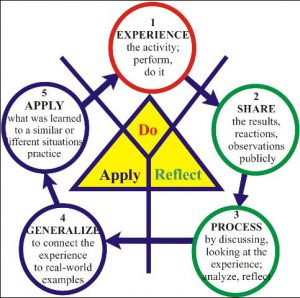STEM Series
Science, Technology, Engineering, and Math (STEM) are a focus priority of Hillsborough 4-H. Through different activities, volunteers can encourage life skill development in areas such as critical thinking and teamwork through STEM activities. These activities can also encourage youth (and parents) to think beyond their project area. Through this blog, I will provide STEM activities to clubs and discussion suggestions designed to lead kids through the Experiential Learning Model.
The Experiential Learning Model is used with targeted questions to take youth through all phases of an activity. This learning model can be simplified into three parts: Do, Reflect, Apply. The key to the model is in the questions. For more information on the Experiential Learning Model, visit http://edis.ifas.ufl.edu/m/#publication?id=4H243

Activity 1: Pasta Bridges
Supplies: variety of uncooked pasta, glue, hot glue & hot glue guns, bag ties, tape, graph paper, pencils, weights and more.
Challenge: Youth will design and engineer a weight bearing bridge using uncooked pasta. After it’s built, have them record the amount of weight their bridges can hold.
Do
Experience: Provide kids with supplies and simple instructions and let their creativity take over. Encourage them to plan and draw out their design before building. As they are working, asking a few questions may keep their ideas flowing. It could also encourage them to stop and think about their next steps.
- What do you expect your bridge to look like?
- What else could you try?
Reflect
Next, lead a discussion on what happened during the activity. Give kids the opportunity to reflect on what happened and how their decisions impacted the activity.
Share:
- What did you do?
- What happened?
- Did your choice of pasta effect your bridge? How?
- How did your design effect your bridge?
- What was easy about this activity?
- What was hard about this activity?
- How did you feel when…?
Process:
- Did your group members have the same experiences?
- What problems happened over and over?
- What was key in a successfully built bridge? What was key in a failing bridge?
- What would make this activity easier?
- What would you change about the activity?
Apply
The apply portion is the most important part to the Experiential Learning Model. Lead youth through a discussion of how this activity can be applied to something they are familiar with (like their project). Then of how this activity can be applied to real world issues in their community. Most importantly, encourage them to think beyond themselves.
Generalize:
- What did you learn about yourself when building this bridge?
- What did you learn about making decisions?
- What skills did you use building this bridge?
- How is this activity similar to your project? HINT: This is where our project leaders need to be creative.
- How do different shapes used in a bridge provide structure and balance? Can this example be used to emphasize setting up livestock in the show ring? Or leg position in a saddle? Or stance in shooting sports?
- How can their experiences in working as a team help them in their club? Or with their animal?
- How can their design and record keeping help them in goal setting?
Apply:
- What is another situation where you can use these skills?
- In their neighborhood
- in their town
- in their county
- in their state
- How will these skills benefit you in the future?
- How can these skills help you when applying for your first job?
For more information on STEM and 4-H Youth Development, contact the Hillsborough 4-H Office at 813-744-5519.
Happy building!
 0
0
